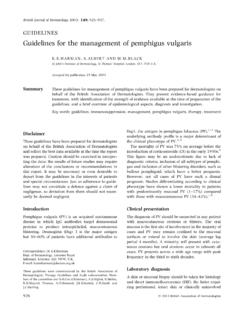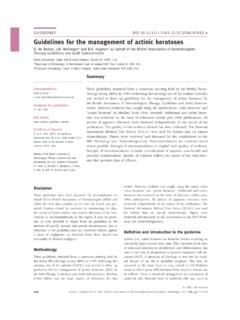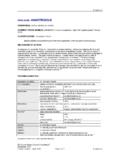Transcription of Canadian Guidelines for the Management of …
1 BASIC/CLINICAL SCIENCEC anadian Guidelines for the Management of PlaquePsoriasis: OverviewKim Papp, Wayne Gulliver, Charles Lynde, Yves Poulin, and John Ashkenas for the Canadian psoriasis GuidelinesCommittee*New clinical treatment Guidelines for plaque psoriasis , written by a panel of 16 Canadian dermatologists, were recently publishedonline. TheseCanadian Guidelines for the Management of plaque Psoriasisare evidence based and free of any influence fromcorporate sponsors and have been endorsed by the Canadian Dermatology Association (CDA). TheGuidelinesoffer treatmentrecommendations for mild and moderate to severe body psoriasis , as well as for psoriasis affecting specific areas of the skin, such asthe facial, flexural, and genital areas; nails; scalp; and palms and soles. The present overview describes the genesis and contents oftheGuidelines, which are available in full through the CDA at, (English) or, (French).
2 De nouvelles lignes directrices sur le traitement clinique du psoriasis en plaques, re dige es par un groupe de 16 dermatologues duCanada, ont e te re cemment publie es en ligne. CesLignes directrices canadiennes pour la prise en charge du psoriasis en plaquessontfonde es sur des donne es probantes et a` l abri de toute influence des socie te s commanditaires; en outre, elles ont e te endosse es parl Association canadienne de dermatologie (ACD). LesLignes directricesoffrent des recommandations en matie`re de traitement desformes le ge`res, mode re es a` graves de psoriasis du corps, ainsi que du psoriasis qui touche des re gions particulie`res de la peau,comme la re gion faciale, les plis, et la partie ge nitale ; les ongles ; le cuir chevelu ; et les paumes ainsi que les plantes du pied.
3 Lepre sent aperc u de crit la gene`se et le contenu desLignes directrices, que vous pouvez vous procurer dans leur inte gralite aupre`s del Association canadienne de dermatologie a` l adresse, (franc ais) et, (anglais). plaque PSORIASISis a chronic inflammatory skindisease that requires ongoing, lifelong care. Plaquepsoriasis is distinguished by the presence of erythematousplaques, usually covered with silver, flaking scales. Theseplaques may be itchy or painful; depending on their extentand location, they may also be physically debilitating orsocially psoriasis imposes a burden of disease thatextends far beyond the physical dermatologic may lead to stigmatization, high levels of stress,and poor self-esteem,1 6with pervasive negative effects onsocial functioning, interpersonal relationships, and successat school or ,8 Patients with more severe disease orwith involvement of a more visible ( , face or scalp) orhighly used ( , hands)
4 Area of the body may sufferdisproportionately from these ,physicians frequently underestimate the degree of psycho-logical and social impact of this ,10,11 psoriasis patients are also at risk for a wide variety ofserious clinical comorbidities that add to their burden,complicate Management , and increase the risk ofpremature death. Metabolic syndrome and relatedcardiovascular diseases are more common in psoriasispatients. psoriasis per se is a risk factor for cardiovas-cular disease, conferring an approximately threefoldincreased relative risk of myocardial infarction inFrom K. Papp Clinical Research, Waterloo, ON; Probity MedicalResearch, Waterloo, ON; Newlab Clinical Research Inc., St. John s, NL;Memorial University, St John s, NL; Lynderm Research Inc.
5 , Markham,ON; University of Toronto, Toronto, ON; Centre Dermatologique duQue bec, Me tropolitain, Que bec, QC; Universite Laval, Que bec, QC; andSCRIPT, Toronto, ON.*Members of the psoriasis Guidelines Committee (in alphabetical order):Stewart P. Adams, Lorne Albrecht, Benjamin Barankin, Kirk Barber,Marc Bourcier, Wayne Carey, Lyn C. Guenther, Wayne Gulliver, VincentC. Ho, Charles W. Lynde, Kim Alexander Papp, Yves Poulin, Neil , John Toole, Ronald Vender, and Norman #2011 Canadian Dermatology AssociationAddress reprint requests to: Kim Papp, MD, PhD, FRCPC, 135 Union , Waterloo, ON N2J 1C4; E-mail: of Cutaneous Medicine and Surgery, Vol 15, No 4 (July/August), 2011: pp 210 219younger psoriasis psoriasis is alsoassociated with an increased risk of mortality, leading females, respectively, relative to individuals clinical treatment Guidelines for psoriasis havebeen lacking in Canada.
6 We therefore undertook to developclinically relevant, patient-focused, evidence-based guide-lines with recommendation for the Management of plaquepsoriasis. The resulting document is available online at, we offer an overview of the development and thefindings of theCanadian Guidelines for the Management ofPlaque psoriasis . We emphasize the treatment optionsdiscussed in the chapter on moderate to severe bodypsoriasis. The reader is referred directly to theGuidelines14for evidence-based Management recommendations onother aspects of psoriasis care. These can be found inchapters on mild body psoriasis ; facial, flexural, and genitalpsoriasis; nail psoriasis ; scalp psoriasis ; palmoplantarpsoriasis; psoriatic flares; psoriasis treatment in specialpopulations and circumstances (including pediatric andelderly patients, pregnant and lactating women, andindividuals with hepatitis, human immunodeficiency virus[HIV], or a history of cancer); psoriasis comorbidities.
7 Andsocial and psychological aspects of process endeavored to meetthe standards of the international AGREE (Appraisal ofGuidelines for Research & Evaluation) Instrument15andthe Canadian Medical Association sHandbook on ClinicalPractice Committee StructureThe Guidelines Committee was subdivided into fourgroups: the Steering Committee, the Section Heads,the Evidence Committee, and the Steering Committee set the parameters for theGuidelinesand monitored the progress of the Section Heads worked with a team of professionalmedical writers to produce the first draft of the manu-script. The Evidence Committee ratified the assignedlevel of evidence for each recommendation, and theRecommendations Committee did the same for theassigned grade of each of EvidenceSection Heads identified key terms that were used tosearchPubMedandEMBASEfor papers on psoriasis andantipsoriatic therapies, published in 1980 or later.
8 All peer-reviewed literature was considered. In all, 5,439 peer-reviewed research articles were judged to be relevant toCanadian modified version of the Scottish IntercollegiateGuidelines Network (SIGN) system17was used to assignlevels of evidence and grade the treatment recommenda-tions (Table 1). SIGN assigns levels of evidence (A, B, C, D) was then applied accordingto the level of evidence, with considered judgment allowing some flexibility in converting level of evidence(LoE) into a recommendation of Industry Sponsors and CommunityReviewersAfter a complete draft of theGuidelineshad been revised tothe satisfaction of Committee members and all treatmentrecommendations were approved, the document was circu-lated to 17 Canadian or international authorities on psoriasiscare or family practice.
9 These community reviewers com-ments were incorporated to produce a final Canadian pharmaceutical companies supported thedevelopment of theGuidelinesthrough unrestricted sponsors were encouraged to submit unpublishedmanuscripts for the Committee s consideration during thedrafting of the document; for the corresponding informa-tion to remain in the final document, these manuscripts hadto be accepted for publication by February 15, received regular progress reports but were notinformed of the identity of Guidelines Committeemembers. Sponsors were not party to discussions of theGuidelines content and did not see the manuscript untilthe final draft was of plaque PsoriaisisLarge-scale population studies in the United Kingdom18and the United States1found that and ofindividuals, respectively, had been diagnosed with pso-riasis.
10 As shown in Table 2, application of age-specificpsoriasis prevalence rates from the United Kingdom to theCanadian population suggests that more than 500,000 Canadians (approximately of the population) haveCanadian psoriasis Guidelines211psoriasis. This affected population includes approximately40,000 older individuals ($70 years) and 20,000 children(#10 years). Given the prevalence of plaque psoriasis , allphysicians are likely to confront this burdensome chronicdisease in the course of routine psoriasis CareAccording to the guiding principle of patient-centeredcare, as developed in theGuidelines, treatment adequacyshould be judged on the basis of the patient s perception ofthe disease and its SIGN System Used by the Evidence and Recommendations CommitteesLevels of Evidence1++High-quality meta-analyses, systematic reviews of RCTs, or RCTs with a very low risk of bias1+Well-conducted meta-analyses, systematic reviews of RCTs, or RCTs with a low risk of bias12 Meta-analyses, systematic reviews of RCTs.


